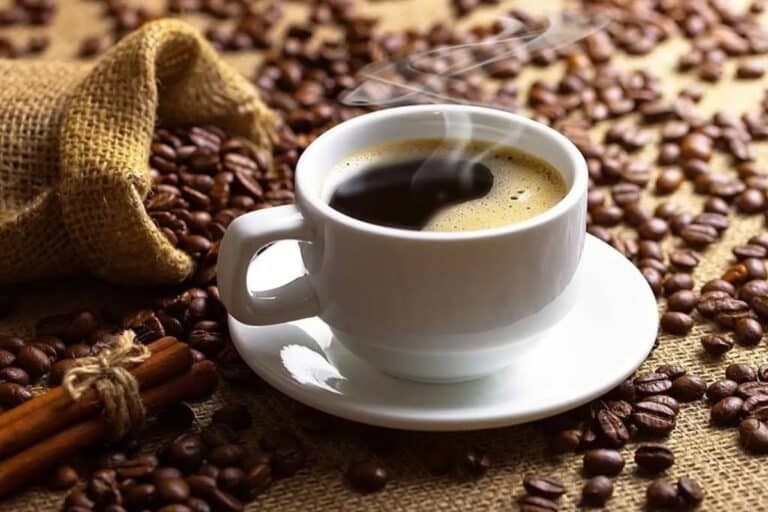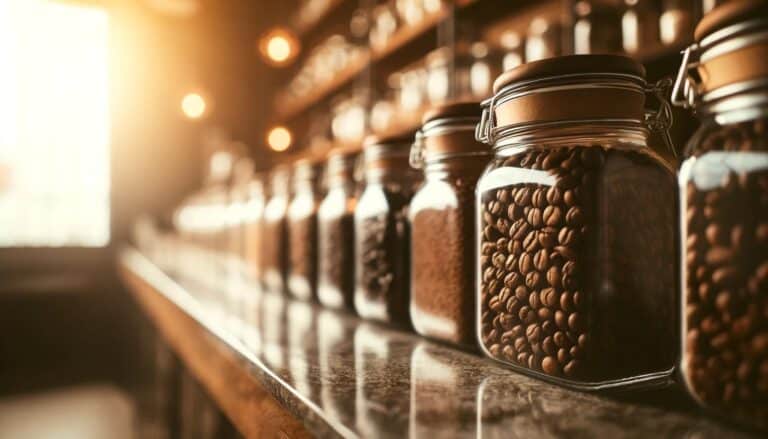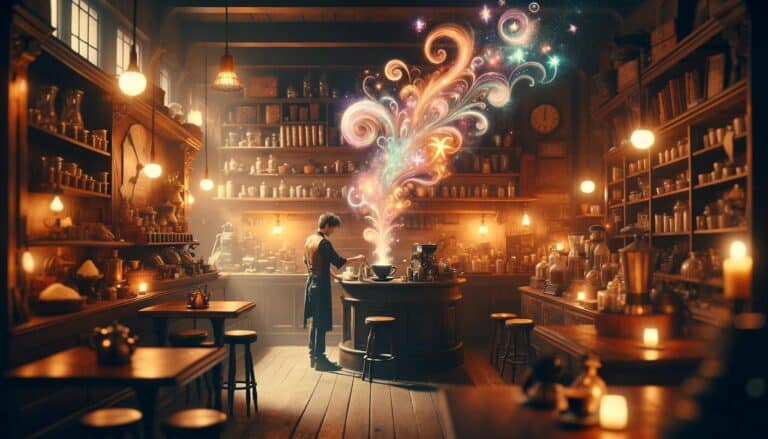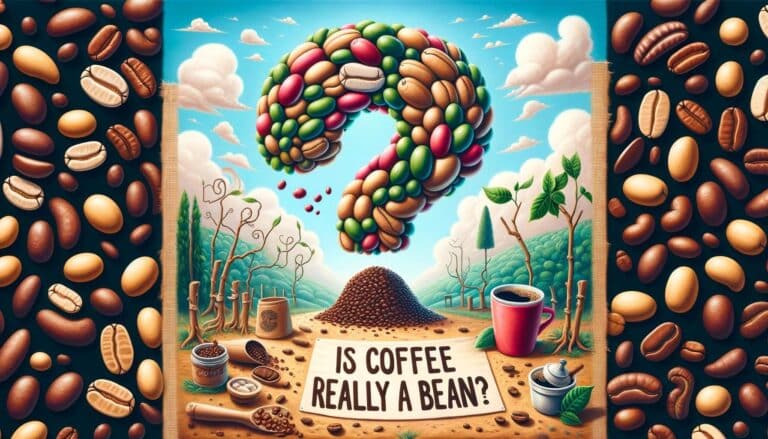People love Irish Coffee because it mixes coffee’s rich, bold flavors with the smooth, warm notes of Irish whiskey, all under a layer of creamy, slightly sweetened whipped cream. Drinking this delightful mix isn’t just about enjoying a beverage; it’s about experiencing a mix of culture, tradition, and culinary artistry that warms both the body and soul.
A man named Joe Sheridan, a chef at Foynes Airbase near Limerick, Ireland, invented Irish Coffee back in the 1940s. On a cold winter night, he created this innovative drink to warm up passengers by mixing the comforting warmth of coffee with the strong taste of whiskey, and making it sweeter and smoother with sugar and cream. This beverage quickly became popular and traveled from the cozy shores of Ireland to the busy streets of San Francisco, where Stanton Delaplane, a travel writer, introduced it to Americans.
Now, Irish Coffee stands as a symbol of Irish hospitality and creativity, celebrated worldwide, especially on St. Patrick’s Day. It shows a rich cultural tradition that the world has welcomed, offering a taste of Ireland’s warmth and spirit in every sip. People enjoy Irish Coffee in cozy pubs, fine dining restaurants, or at home, proving it’s a blend of simple ingredients brought together with care and craftsmanship that continues to win hearts.
What is an Irish Coffee?
Irish Coffee is a popular cocktail consisting of hot coffee, Irish whiskey, sugar, and topped with a layer of cream. The sugar is essential as it helps the cream float on top of the coffee. The drink is both warming and invigorating, making it especially popular in colder months or as an after-dinner treat.
The History of Irish Coffee
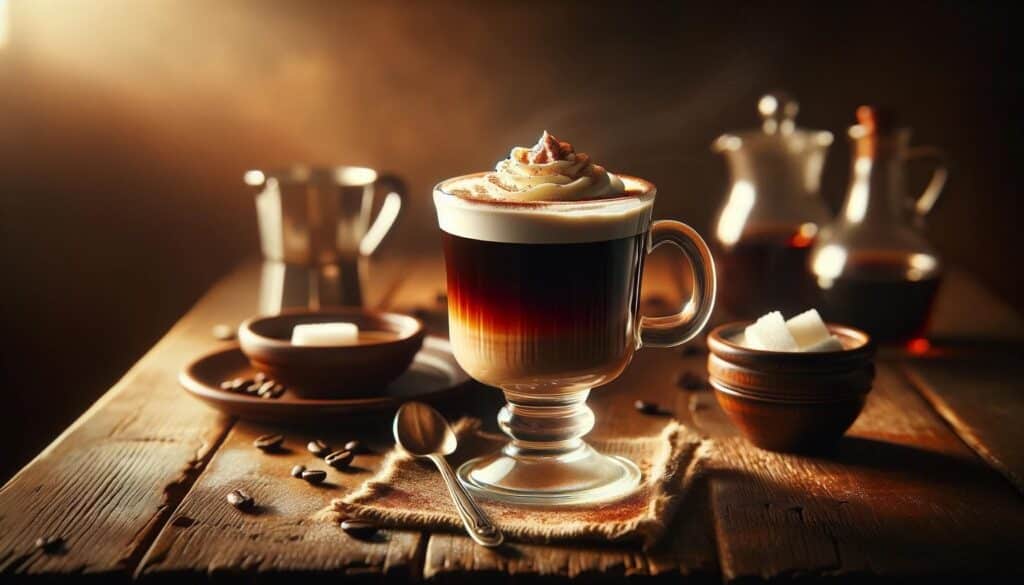
Irish Coffee’s intriguing history is a tale of serendipity, hospitality, and global charm, originating from a stormy night at Foynes Airbase in the early 1940s. This section delves into its humble beginnings, its rise to fame in Ireland, its triumphant crossing to the United States, and the subsequent evolution of its recipe.
The Origin Story: Foynes Airbase and Joe Sheridan
The creation of Irish Coffee is attributed to Joe Sheridan, a chef at the Foynes Airbase, a key transatlantic flight refueling point for seaplanes near Limerick, Ireland. On a cold winter night in 1943, a flight bound for North America was forced to return to Foynes due to inclement weather. To warm the weary passengers, Sheridan added whiskey to their coffee, marking the birth of Irish Coffee. When asked if they were being served Brazilian coffee, Sheridan joked that it was “Irish coffee,” a name that stuck.
Popularity in Ireland and Introduction to the United States
Irish Coffee quickly became a favorite among travelers and locals alike, symbolizing Irish hospitality. Its journey to international fame began when Stanton Delaplane, a travel writer for the San Francisco Chronicle, experienced the warm concoction at Shannon Airport (the successor to Foynes). Charmed by its taste and warmth, Delaplane collaborated with the owners of the Buena Vista Café in San Francisco to recreate the beverage. After numerous experiments to perfect the floating cream on top, Irish Coffee was introduced to the United States in 1952, where it became an instant hit.
Evolution of the Recipe Over Time
The original Irish Coffee recipe has undergone various transformations, adapting to regional tastes and available ingredients. The basic components—hot coffee, Irish whiskey, sugar, and cream—have remained constant. However, the type of coffee and whiskey, the method of incorporating sugar, and the technique for whipping the cream have seen variations. Some versions use espresso for a stronger coffee base, while others experiment with different Irish whiskeys for varying flavor profiles. The method of layering the cream has also evolved, with bartenders and home enthusiasts alike striving for the perfect texture and presentation.
Throughout its history, Irish Coffee has maintained its status as a beloved beverage, transcending its simple origins to become a global favorite. Its enduring appeal lies in its ability to embody the warmth, creativity, and spirit of Ireland, making it a timeless classic in the world of cocktails.
What Makes an Irish Coffee?
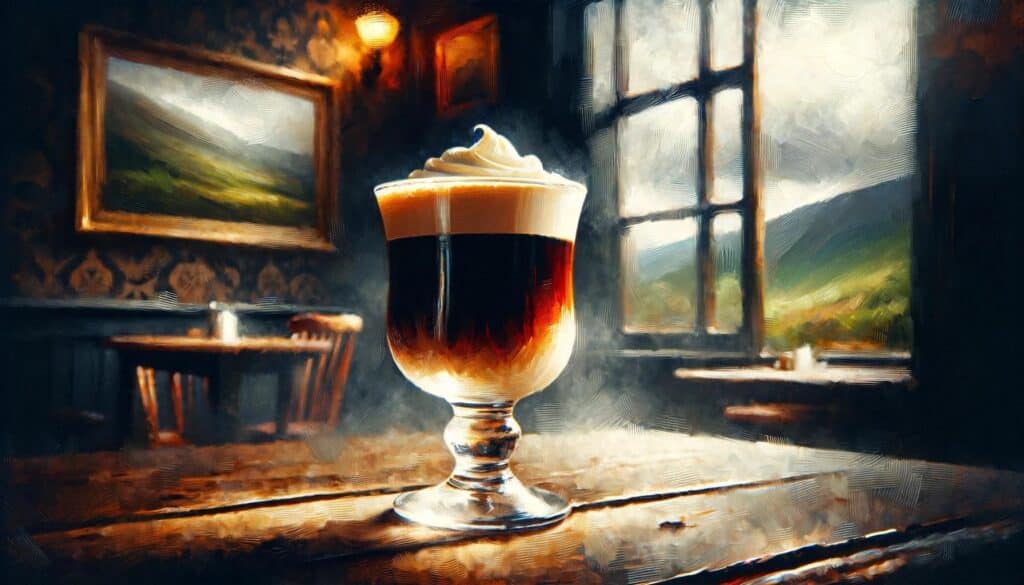
Irish Coffee is more than just a drink; it’s a harmonious blend of simplicity and sophistication. At its core, Irish Coffee combines four essential ingredients: coffee, Irish whiskey, sugar, and cream. However, the magic of this beverage lies not just in its components but in how they’re brought together and the quality of each element.
Basic Ingredients: Coffee, Irish Whiskey, Sugar, and Cream
- Coffee: The foundation of Irish Coffee is a strong, hot coffee. Traditionally, a medium to dark roast is preferred for its robust flavor that can stand up to the whiskey.
- Irish Whiskey: Irish whiskey is chosen for its smooth, complex flavor profile. Its warmth and character add depth to the coffee, creating a perfect balance.
- Sugar: Brown sugar is typically used for its molasses-like flavor, which complements the whiskey. It not only sweetens the drink but also helps the cream float on top by increasing the density of the coffee.
- Cream: Fresh, thick cream lightly whipped to a pourable consistency is gently floated over the back of a spoon on top of the coffee. The cream should be rich but not too whipped, allowing it to delicately sit atop the coffee and whiskey mixture.
Variations in Ingredients and Preparation Methods
While the basic ingredients remain consistent, variations exist that cater to personal preferences and regional tastes. Some variations include:
- Coffee Type: Espresso or cold brew can be used for a stronger coffee base.
- Whiskey Alternatives: Different brands of Irish whiskey can alter the drink’s flavor profile. Some variations even explore other types of whiskey, though this strays from the traditional recipe.
- Sugar Substitutes: While brown sugar is traditional, some recipes use white sugar, honey, or even syrup for a different kind of sweetness.
- Cream Alternatives: Heavy cream is traditional, but some opt for lighter versions or even flavored creams to add a twist.
Importance of the Quality of Each Component
The secret to an exceptional Irish Coffee lies in the quality of its ingredients:
- High-Quality Coffee: A freshly brewed, strong coffee is essential for a rich flavor that complements the whiskey.
- Premium Irish Whiskey: The whiskey should be of good quality, offering smoothness and depth without overpowering the coffee.
- Fresh Cream: The cream should be fresh and capable of being whipped to just the right consistency. It’s crucial for achieving the classic layered effect.
- Proper Sweetness: The type and amount of sugar should perfectly balance the bitterness of the coffee and the strength of the whiskey.
Each component’s quality and how they’re combined determine the drink’s overall balance and taste. An expertly crafted Irish Coffee offers a seamless blend of these elements, creating a delightful experience that is both comforting and invigorating.
How to Make the Perfect Irish Coffee

Creating the perfect Irish Coffee is an art that combines the right ingredients with precise techniques. Follow this step-by-step guide to craft a classic Irish Coffee that’s sure to impress.
Step-by-Step Preparation Guide
- Warm the Glass: Start by filling your serving glass with hot water to warm it up. After a minute, discard the water. This helps keep your Irish Coffee warm longer.
- Brew the Coffee: Brew a strong, hot coffee. A French press or drip coffee works well, aiming for about 4-6 ounces per serving.
- Add the Sugar: Add about two teaspoons of brown sugar to the warm glass. Pour in the hot coffee and stir until the sugar is completely dissolved.
- Add the Irish Whiskey: Pour in 1.5 ounces (about one standard shot) of Irish whiskey into the glass and stir well to combine with the sweetened coffee.
- Whip the Cream: Lightly whip fresh heavy cream until it’s slightly thickened but still pourable. Avoid over-whipping; the cream should not form stiff peaks.
- Float the Cream: Hold a warm spoon over the top of your coffee and whiskey mixture, and gently pour the whipped cream over the back of the spoon. The cream should float on top of the coffee, creating a distinct layer.
Tips for Brewing the Coffee and Whipping the Cream
- Coffee: Use freshly ground coffee beans for the best flavor. The coffee should be strong as it needs to balance the whiskey.
- Cream: Use cold heavy cream for easier whipping. Whip it just before serving to ensure it’s fresh and has the best texture for floating.
Common Mistakes to Avoid
- Using Low-Quality Ingredients: The quality of the coffee, whiskey, and cream greatly affects the final taste. Use the best ingredients you can find.
- Over-Whipping the Cream: The cream should be lightly whipped to a pourable consistency. Over-whipped cream will not float properly and can mix into the coffee too quickly.
- Not Dissolving the Sugar: Ensure the sugar is fully dissolved in the hot coffee before adding the whiskey. Undissolved sugar will affect the drink’s texture and sweetness balance.
- Pouring the Cream Too Quickly or Directly: Pour the cream slowly over the back of a spoon to achieve the perfect float. Pouring directly into the coffee will cause the layers to mix.
By following these steps and tips, you can create a traditional Irish Coffee that’s as delicious to drink as it is beautiful to behold. Enjoy the warm, comforting embrace of this classic Irish beverage, perfect for any occasion.
Variations of Irish Coffee
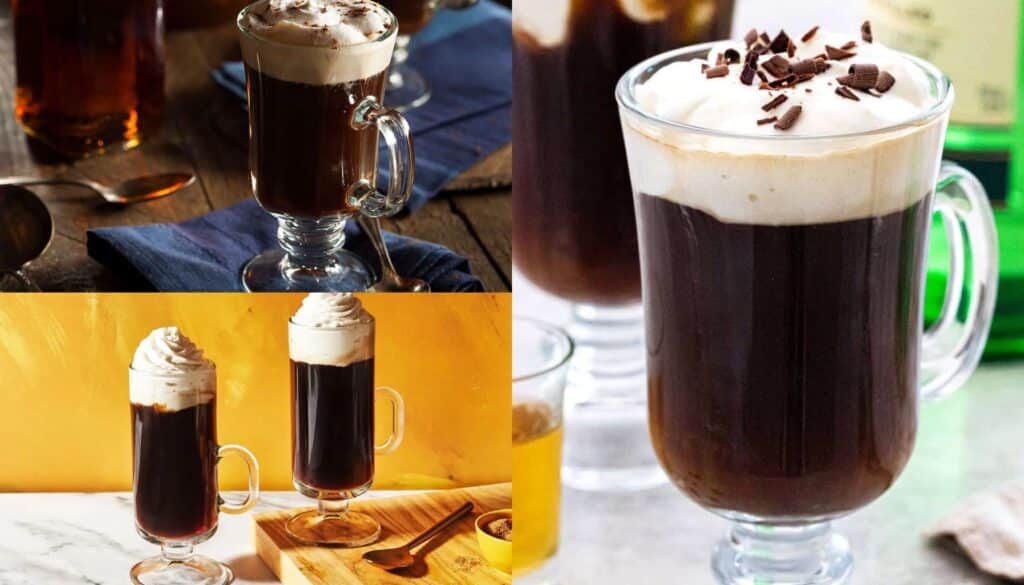
The classic Irish Coffee has inspired a plethora of variations, adapting to modern tastes, international influences, and even non-alcoholic preferences. These twists on the traditional recipe offer something for everyone, from the coffee enthusiast to the cocktail aficionado, showcasing the versatility of this beloved beverage.
Modern Twists and International Variations
- Iced Irish Coffee: A refreshing take on the classic, using cold brew coffee and served over ice, perfect for warmer climates or summer months.
- Spiced Irish Coffee: Incorporating spices such as cinnamon, nutmeg, or vanilla into the sugar or cream for a warm, aromatic twist.
- Irish Coffee Martini: A cocktail version that combines cold coffee, Irish whiskey, and coffee liqueur, shaken over ice and served in a martini glass with a cream float.
- Baileys Irish Coffee: Substituting the traditional whiskey with Baileys Irish Cream for a sweeter, creamier drink.
- Scottish Coffee: Replacing Irish whiskey with Scotch whisky, offering a smokier flavor profile unique to Scottish distillations.
Non-Alcoholic Versions
- Non-Alcoholic Irish Coffee: Utilizing decaffeinated coffee and a non-alcoholic whiskey alternative or whiskey-flavored syrup, topped with whipped cream for the full experience without the alcohol.
- Irish Cream Coffee: Incorporating non-alcoholic Irish cream syrup in place of whiskey and alcohol-free whipped cream for a family-friendly version.
Seasonal and Regional Specialties
- Pumpkin Spice Irish Coffee: A fall favorite that blends pumpkin spice into the cream or directly into the brew, capturing the essence of autumn.
- Mexican Irish Coffee: Infused with a hint of chocolate and cinnamon, and made with Mexican coffee and tequila instead of Irish whiskey, for a rich, complex flavor.
- Caramel Irish Coffee: Featuring caramel syrup either mixed with the coffee or drizzled over the cream, offering a sweet, indulgent variation.
These variations of Irish Coffee reflect the drink’s global appeal and the creativity it inspires. Whether sticking to the classic recipe or exploring these modern twists and regional specialties, Irish Coffee remains a versatile and beloved beverage. Each version offers a unique way to enjoy the rich interplay of coffee, cream, and, where applicable, the spirit of choice, ensuring that there’s an Irish Coffee out there for every palate.
The Role of Irish Coffee in Culture and Society

Irish Coffee has transcended its humble origins to become a cultural icon, savored in bars and restaurants worldwide and featured in numerous celebrations, media, and popular culture. Its universal appeal and comforting warmth make it more than just a beverage—it’s a symbol of hospitality, creativity, and connection.
Irish Coffee in Bars and Restaurants Around the World
Globally, Irish Coffee holds a revered spot on the menu of many bars and restaurants, from traditional Irish pubs to high-end cocktail lounges. It’s often served as a warm welcome, a nightcap, or a sophisticated cocktail choice, demonstrating its versatility and widespread popularity. Establishments may offer their unique take on the classic recipe, incorporating local flavors or modern twists, yet the essence of Irish Coffee—combining coffee, whiskey, sugar, and cream—remains a constant, beloved feature.
Its Place in Celebrations and Gatherings
Irish Coffee is a staple at various celebrations and gatherings, embodying a sense of warmth and festivity. It’s particularly popular on St. Patrick’s Day, where it’s enjoyed by people of all backgrounds in honor of Irish culture and heritage. Moreover, its comforting nature makes it a favorite choice during the holiday season, at weddings, and in family gatherings, serving as a toast to togetherness and joy.
Representation in Media and Popular Culture
The allure of Irish Coffee extends into media and popular culture, where it has been featured in films, television shows, books, and songs, often symbolizing a moment of solace, a catalyst for conversation, or a touch of Irish charm. Its iconic status is also reflected in its presence on social media, where enthusiasts share recipes, photos, and stories of their Irish Coffee experiences, further cementing its role as a beverage that connects people across different cultures and walks of life.
Irish Coffee’s enduring appeal lies in its simplicity, its rich history, and its ability to bring people together. It stands as a testament to the power of food and drink in cultural expression and social bonding, offering a sip of Irish tradition that resonates worldwide. Whether enjoyed in a cozy pub, a bustling city café, or a quiet home, Irish Coffee remains a cherished part of culture and society, symbolizing warmth, hospitality, and the joy of shared moments.
Conclusion
Irish Coffee, with its perfect blend of coffee, Irish whiskey, sugar, and cream, transcends the boundaries of a mere beverage to become a symbol of warmth, creativity, and cultural heritage. Its origins at Foynes Airbase, the brainchild of Joe Sheridan, have blossomed into a global phenomenon, celebrated in the cozy corners of Irish pubs and the chic ambiance of international cocktail bars alike. This delightful concoction not only warms the body but also the soul, embodying the spirit of Irish hospitality and the joy of shared experiences.
The versatility of Irish Coffee is evident in its myriad variations, from iced to spiced, non-alcoholic to seasonal specialties, each adaptation paying homage to the original while inviting personalization and experimentation. Whether it’s the classic warmth of the original or the refreshing twist of an iced version, Irish Coffee offers something for every palate, season, and occasion.
Irish Coffee holds a cherished spot in cultural and social settings, from casual gatherings to festive celebrations. Its representation in media and popular culture further underscores its enduring appeal and iconic status. As a bridge between tradition and modernity, it connects generations and cultures, offering a moment of comfort, a spark of inspiration, or a cause for celebration.
We invite you to explore the rich tradition of Irish Coffee, to experiment with its recipes, and to incorporate this beloved drink into your celebrations and everyday moments. Whether you’re a coffee enthusiast, a whiskey aficionado, or simply someone in search of warmth and comfort, Irish Coffee offers a taste of Ireland’s hospitality and heritage, promising a delightful experience that’s as enriching as it is delicious. So, raise a glass to the enduring charm of Irish Coffee and let its warmth and spirit invigorate your soul.
